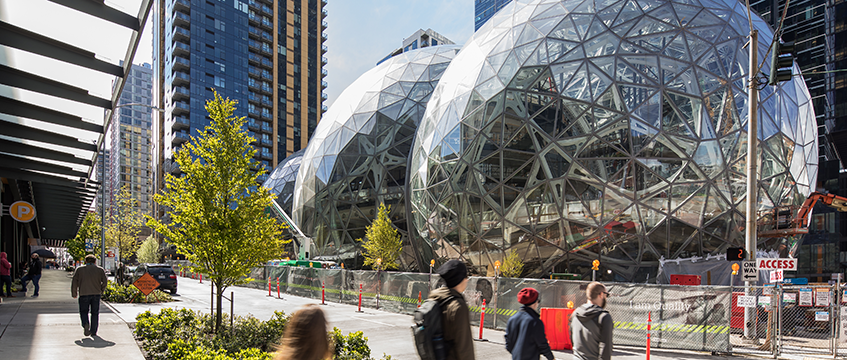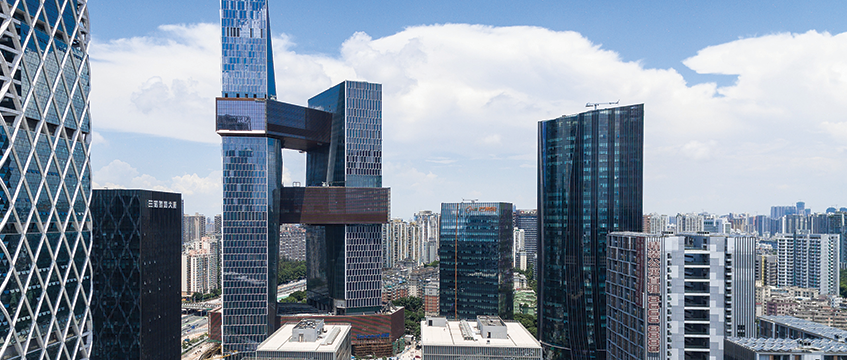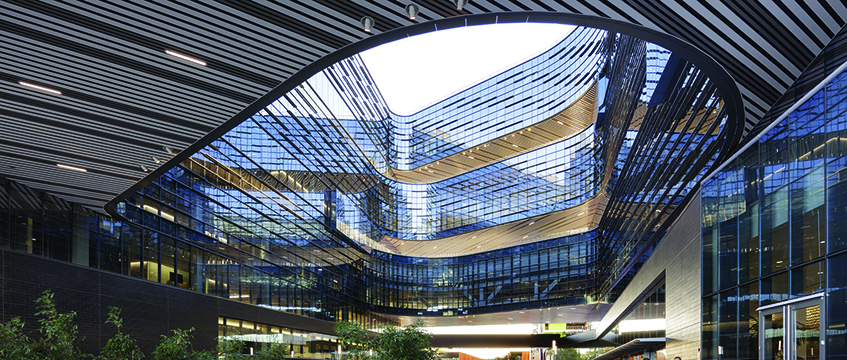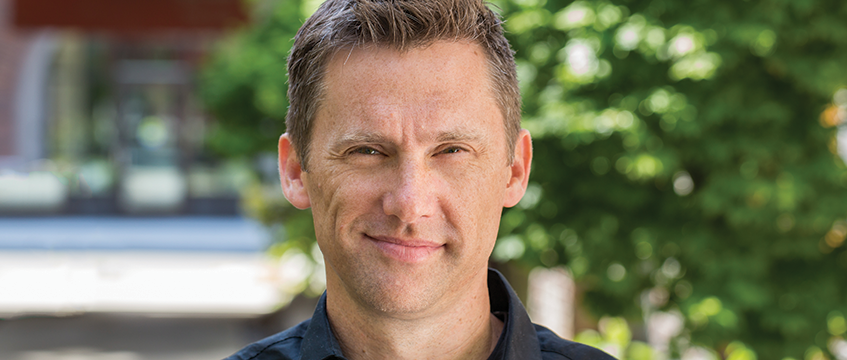Ryan Mullenix knows a thing or two about pressure. A partner at NBBJ, considered one of the most forward-thinking architecture practices in the world, he is under no illusions that with great innovation comes great responsibility.
Based out of the firm’s Seattle headquarters, he has led projects for Amazon, Google, Starbucks and the Bill and Melinda Gates Foundation. On a broader scale, NBBJ counts global occupiers – Samsung, Microsoft and Alibaba, to name a few – among its clients.
With 700 people working out of 10 offices across the world, the firm has a reputation for delivering groundbreaking concepts across sectors including healthcare, sports, higher education and science.
But it is its workplace schemes that are most likely to make the headlines – thrust into the public eye owing to a mix of design innovation and the high-profile nature of the clients involved.
Clients like Amazon.
NBBJ was the designer of its iconic bio-domed headquarters, as well as the firm’s more recent Rainier Square project. This $570m (£433m) scheme, the second-tallest building in Seattle, became front-page news last month when it was revealed that Amazon was set to take all 722,000 sq ft of the scheme’s office space despite its plan to establish a second North American headquarters.
“We have been fortunate enough to work and spend a lot of time with global disruptors,” says Mullenix. “And I don’t use that term lightly. These are companies that, for better or worse, are shaping the future of our world. And we can’t help but have some of that culture influence, or even force, our process.”
Here he reveals how he copes with the “healthy chaos” that is part and parcel of designing office buildings for the world’s most disruptive businesses and why he hopes the days of “beauty contest” architecture are behind us.
Pressure as a by-product
As for that pressure, Mullenix says it is a natural by-product of working at a legacy practice, where partners, designers and creatives in years gone by have built up a reputation for being consistently groundbreaking that the incumbent team must uphold.
“NBBJ is celebrating its 75th anniversary next year,” he says. “That’s so many generations that have passed through this firm and the pressure is on to stay at the forefront. It is a pressure to never fall behind. It is a pressure to be constantly looking at who you are and what you are doing and where you are heading.

“We always want to be challenging the norm here too, which is added pressure. A good indicator of how well we are achieving that is by looking at the staff. If they get bored one day when they are working here, we have failed them.”
NBBJ’s tactic has been to balance this appetite to innovate against a more measured growth strategy. This has been a particular focus amid the exponential rise of the tech giants over the past few years – companies, such as Amazon, that NBBJ has been working with for a long time but that have more recently propelled them further into the limelight.
“Growth is not about knee-jerk reactions,” says Mullenix. “We have a rigorous process in place and we don’t grow for the sake of growth. We do not set up offices wherever a project might be. But working with the tech companies, and their requirements to be disruptive, is forcing us to adopt a similar mentality as a firm.”
By this, he is referring in part to process and staff set-up. To stay agile, NBBJ thinks of itself as a group of 40- to 50-person workshops with access to a resource of 700 people.
“By creating something that is similar in set-up to some of those smaller-design ateliers, we have created the opportunity to have conversations that often get lost in big corporate practices,” Mullenix says. “It allows us to have very frank conversations and it also allows us to find the right idea for each project, whether it comes from the project lead or someone who is interning for the summer.”
It is this fluid approach to the management of a design that allows the firm to work with such ambitious and demanding clients.
But Mullenix says there is always a sense of “healthy chaos” underpinning each scheme. “It is not the same as working on more conventional projects where we map out a process,” he says. “The chaos part is being able to adapt – quickly and often. I can tell you first hand, it doesn’t matter how much you map out the project, ultimately you have to plan for disruption.
“Luckily, I love the ambiguity. I have enough of a creative background that I don’t mind that process. It is not always comfortable. But it shouldn’t always be comfortable. Stress and pressure are what it means to be this sort of firm. The pressure of making sure these high-profile buildings are right for now and will be right 100 years from now.”
Public recognition
The prominent nature of many of the schemes NBBJ takes on, particularly in the corporate offices part of the practice, means that the firm’s work is often recognised around the world.
As to whether the design intricacies and thought processes behind the final aesthetic are fully appreciated, Mullenix says he hopes that the critique goes beyond the finished look.
“I do feel as though we have transcended the 1990s and 2000s, when design was more about trophy buildings. A lot of overseas work at that time in particular was for what we would consider a beauty contest. Things are different now.
“We are working on Tencent’s 270,000 sq m HQ in China at the moment. The concept is two high-rises physically connected at three points to avoid the danger of people feeling isolated. You can disappear into some of those huge high-rise towers, get in to the lift and then never see your colleagues. We are trying to recreate what it means to work in a transparent, open-plan building through the original design and structure.
“We are working on another scheme at the moment where we have physically divided the floor up into a noisy part and a quiet part. As basic as that sounds, it is a fresh way to design and it goes beyond the final look. It is about experience. People can arrive at work every day and decide which section to go to depending on their mood and tasks. That is becoming more and more the basis of how we think here.”

He adds that longevity is a huge focus for him specifically, and NBBJ in general. The firm may be known for coming up with weird and wonderful concepts and fresh ideas to break the mould, but ultimately NBBJ is looking to create buildings that will stand the test of time.
“Commercial buildings here in the US have an average life span of fewer than 70 years,” says Mullenix. “That is a remarkable thing to me. We are building these things out of concrete and steel and they have shorter life spans than a frail, human body. That is a huge amount of waste. A waste of space, materials and design energy.
“Our responsibility as designers is to change that and to pull other companies along with us. Part of that is about thinking properly about futureproofing our buildings, making them flexible and easy to adapt to change.
“But it is also about making our cities as liveable as possible. That has a knock-on effect as it reduces the sprawl that happens beyond the city edges and means we can focus on preserving natural areas. If cities aren’t liveable, people leave and that’s when we run into overconsumption issues.”
The dangers of a myopic view
Speaking of liveable cities, Mullenix also warns of the dangers of becoming focused on only one industry. It is a pertinent point to make, as a Seattleite operating out of a city well known for being dominated by a particular company. But he adds that Amazon’s disproportionate profile masks a lot of other activity.
“I think the prominence of some of the tech companies means that Seattle’s history and diversity gets a bit lost. Yes, we have Amazon and Google and Microsoft but also retail with Nordstrom and Starbucks. And there is a huge aerospace history here, as well as a long music history.

“Back in the 1950s, the only real entity in Seattle was Boeing. There was a nervous moment when it looked like it might go under and a billboard went up that read ‘Whoever leaves the city last, please make sure you turn the lights out’.
“I think that, since then, Seattleites have understood that when you focus on a sole industry, if those industries pack up or don’t evolve, that the city will die. And so I am tremendously encouraged by all the radically different elements of industry, thinking and innovation here now.”
Tech giants shape the future
And he is quick to add that, far from dying out, the ever-evolving tech giants will continue to shape the future of the world and its built environment.
He says: “Cross-culture development is so incredibly important and technology is going to be at the forefront of that. I mean cross-culture globally but also across markets.
“It all used to be so segregated. People would go to the hospital to be cured of their illnesses and cared for, they went home to sleep and to a hotel to get away. Now all of those activities have started to blend together.
“We worked with a tech client here recently where we had someone from the healthcare team on board as a lead designer, as healthcare has prominence in corporate office design.
“Variety means flexibility and ultimately we owe it to the world, as designers, not just to plan something for the first 10-year lease. We need to be thinking about the fourth generation of people who will be in this building and how they will occupy it.
“To design something now that will be torn down in 70 years’ time? That’s what we have to avoid.”
EG’s Offices & Workplace Summit returns on 23 November at the U&I Building in London, examining the latest workplace innovations and discussing how to better prepare for the future. Click here for more information
To send feedback, e-mail emily.wright@egi.co.uk or tweet @EmilyW_9 or @estatesgazette











